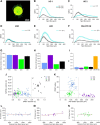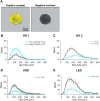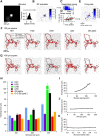Three Small-Receptive-Field Ganglion Cells in the Mouse Retina Are Distinctly Tuned to Size, Speed, and Object Motion
- PMID: 28100743
- PMCID: PMC5242408
- DOI: 10.1523/JNEUROSCI.2804-16.2016
Three Small-Receptive-Field Ganglion Cells in the Mouse Retina Are Distinctly Tuned to Size, Speed, and Object Motion
Abstract
Retinal ganglion cells (RGCs) are frequently divided into functional types by their ability to extract and relay specific features from a visual scene, such as the capacity to discern local or global motion, direction of motion, stimulus orientation, contrast or uniformity, or the presence of large or small objects. Here we introduce three previously uncharacterized, nondirection-selective ON-OFF RGC types that represent a distinct set of feature detectors in the mouse retina. The three high-definition (HD) RGCs possess small receptive-field centers and strong surround suppression. They respond selectively to objects of specific sizes, speeds, and types of motion. We present comprehensive morphological characterization of the HD RGCs and physiological recordings of their light responses, receptive-field size and structure, and synaptic mechanisms of surround suppression. We also explore the similarities and differences between the HD RGCs and a well characterized RGC with a comparably small receptive field, the local edge detector, in response to moving objects and textures. We model populations of each RGC type to study how they differ in their performance tracking a moving object. These results, besides introducing three new RGC types that together constitute a substantial fraction of mouse RGCs, provide insights into the role of different circuits in shaping RGC receptive fields and establish a foundation for continued study of the mechanisms of surround suppression and the neural basis of motion detection.
Significance statement: The output cells of the retina, retinal ganglion cells (RGCs), are a diverse group of ∼40 distinct neuron types that are often assigned "feature detection" profiles based on the specific aspects of the visual scene to which they respond. Here we describe, for the first time, morphological and physiological characterization of three new RGC types in the mouse retina, substantially augmenting our understanding of feature selectivity. Experiments and modeling show that while these three "high-definition" RGCs share certain receptive-field properties, they also have distinct tuning to the size, speed, and type of motion on the retina, enabling them to occupy different niches in stimulus space.
Keywords: feature selectivity; object motion; retina; retinal ganglion cell.
Copyright © 2017 the authors 0270-6474/17/370610-16$15.00/0.
Figures










Similar articles
-
Fidelity of the ensemble code for visual motion in primate retina.J Neurophysiol. 2005 Jul;94(1):119-35. doi: 10.1152/jn.01175.2004. Epub 2004 Dec 29. J Neurophysiol. 2005. PMID: 15625091
-
Joint Encoding of Object Motion and Motion Direction in the Salamander Retina.J Neurosci. 2016 Nov 30;36(48):12203-12216. doi: 10.1523/JNEUROSCI.1971-16.2016. J Neurosci. 2016. PMID: 27903729 Free PMC article.
-
The Synaptic and Morphological Basis of Orientation Selectivity in a Polyaxonal Amacrine Cell of the Rabbit Retina.J Neurosci. 2015 Sep 30;35(39):13336-50. doi: 10.1523/JNEUROSCI.1712-15.2015. J Neurosci. 2015. PMID: 26424882 Free PMC article.
-
Feature Detection by Retinal Ganglion Cells.Annu Rev Vis Sci. 2022 Sep 15;8:135-169. doi: 10.1146/annurev-vision-100419-112009. Epub 2022 Apr 6. Annu Rev Vis Sci. 2022. PMID: 35385673 Review.
-
Neural Mechanisms of Motion Processing in the Mammalian Retina.Annu Rev Vis Sci. 2018 Sep 15;4:165-192. doi: 10.1146/annurev-vision-091517-034048. Epub 2018 Aug 10. Annu Rev Vis Sci. 2018. PMID: 30095374 Review.
Cited by
-
Differential susceptibility of retinal ganglion cell subtypes against neurodegenerative diseases.Graefes Arch Clin Exp Ophthalmol. 2022 Jun;260(6):1807-1821. doi: 10.1007/s00417-022-05556-2. Epub 2022 Jan 17. Graefes Arch Clin Exp Ophthalmol. 2022. PMID: 35038014 Review.
-
A Pixel-Encoder Retinal Ganglion Cell with Spatially Offset Excitatory and Inhibitory Receptive Fields.Cell Rep. 2018 Feb 6;22(6):1462-1472. doi: 10.1016/j.celrep.2018.01.037. Cell Rep. 2018. PMID: 29425502 Free PMC article.
-
A Self-Regulating Gap Junction Network of Amacrine Cells Controls Nitric Oxide Release in the Retina.Neuron. 2018 Dec 5;100(5):1149-1162.e5. doi: 10.1016/j.neuron.2018.09.047. Epub 2018 Oct 25. Neuron. 2018. PMID: 30482690 Free PMC article.
-
Neurogenesis and Specification of Retinal Ganglion Cells.Int J Mol Sci. 2020 Jan 10;21(2):451. doi: 10.3390/ijms21020451. Int J Mol Sci. 2020. PMID: 31936811 Free PMC article. Review.
-
New Features of Receptive Fields in Mouse Retina through Spike-triggered Covariance.Exp Neurobiol. 2020 Feb 29;29(1):38-49. doi: 10.5607/en.2020.29.1.38. Exp Neurobiol. 2020. PMID: 32122107 Free PMC article.
References
Publication types
MeSH terms
Grants and funding
LinkOut - more resources
Full Text Sources
Other Literature Sources
Miscellaneous
